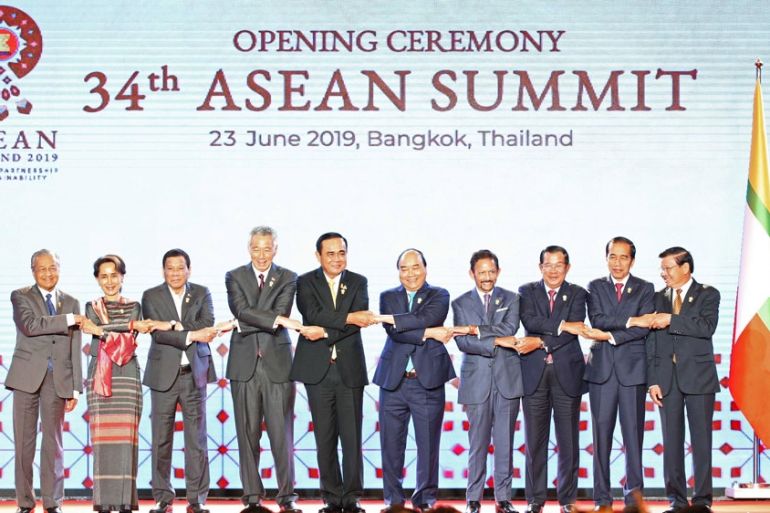Asia responds to US-China tensions with giant trade pact
Pinched by the trade war, Asian countries are being spurred to sign the Regional Comprehensive Trade Partnership.

Tensions between the United States and China have given new impetus to a China-backed trade pact and there is a chance of major progress, if not final agreement, when Southeast Asian leaders meet in Bangkok this week, analysts say.
The Regional Comprehensive Economic Partnership (RCEP) could become the world’s largest free trade zone, comprising 16 countries that account for a third of global gross domestic product and nearly half of the world’s population.
Keep reading
list of 3 itemsThai officials to seek talks with US on loss of trade privileges
‘Calm before a potential storm’: Asian shares rise on trade hopes
Progress since talks began in 2012 has been slowed by disagreements between members, such as major Indian concerns over a possible deluge of imports from China. The pact also includes members of the Association of Southeast Asian Nations (ASEAN), Australia, Japan, New Zealand and South Korea.
Analysts said the pace of discussion on remaining issues had quickened this year, as the US-China trade war sharpened concerns over economic growth and regional security.
“We are hearing that there is light at the end of the tunnel and it is already a short tunnel,” said Tang Siew Mun, head of the ASEAN Studies Centre at the Yusof Ishak Institute in Singapore.
“The momentum is now there for the politicians to get this done,” he told Reuters.
Thailand, which currently chairs ASEAN, said this month that market access talks were 80 percent complete and members had agreed on 14 of a total of 20 chapters. Talks with RCEP members will follow the ASEAN summit, from October 31 to November 4, in Bangkok.
“Some Southeast Asian nations would like to show that they can keep the regional integration show on the road, despite the US-China tensions,” said Benjamin Bland, director of the Southeast Asia project at the Lowy Institute in Sydney.
In Asia, China is not alone in feeling the pressure of the trade war.
Although some companies have moved production from China to escape US tarriffs, the International Monetary Fund (IMF) forecasts that growth in ASEAN’s top five economies will fall to 4.8 percent this year from 5.3 percent in 2018. It expects India’s growth to slow to 6.1 percent from 6.8 percent.
Countries that used to rely on the US as a counterweight to China’s growing regional dominance are also increasingly doubtful if they can.
RCEP members including India, Japan, Malaysia, South Korea and Thailand all have large trade surpluses with the US – a bugbear for President Donald Trump.
US-Thai trade relations have been strained, with Washington withdrawing trade preferences on $1.3bn in Thai goods last Friday, accusing Thailand of failing to protect workers’ rights.
‘Final warning sign’
“The trade tensions should be the final warning sign that Asia needs to have a collective platform and a place for engaging in economic issues,” said Deborah Elms, executive director of the Asian Trade Center based in Singapore.
It would be a “massive missed opportunity” if leaders did not announce the success of the pact at this week’s meeting, Elms added.
The RCEP trade deal aims to build on the free trade deals that Southeast Asian countries have with other members.
It has been widely seen as a China-supported alternative to the Comprehensive and Progressive Agreement for Trans-Pacific Partnership (CPTPP), which covers 11 countries across the Pacific – though Trump pulled the US out of talks before it was signed.
RCEP, seven of whose member nations are also in the other agreement, is less ambitious in terms of the areas of trade that would be freed up and the conditions participants must meet.
But it is still expected to provide a major boost to regional trade, besides being symbolically important, as the Trump administration challenges multilateral trade deals.
“Completing the RCEP negotiations as early as possible is of great significance to the long-term stability, prosperity and development of the region,” Li Chenggang, China’s assistant commerce minister told reporters in Beijing on Monday.
“The negotiations are currently in the final sprint.”
Chinese Premier Li Keqiang is confirmed to attend the Bangkok meet, while the US has yet to announce any representative more senior than Assistant Secretary of State David Stilwell.
Last year, US Vice President Mike Pence joined the meeting with Southeast Asian leaders in Trump’s place.
Other issues that may figure at the Southeast Asian summit include the standoff between China and several regional states over its sweeping maritime claims in the South China Sea, as well as Myanmar’s treatment of Muslim-majority Rohingya after a military crackdown drove more than 700,000 into Bangladesh in 2017.
But with Thai hosts eager to show progress on the RCEP deal, analysts and diplomats say it is shaping up to be the most important issue in Bangkok.
“ASEAN hopes to at least be able to announce that substantial progress has been made, to ensure momentum is sustained,” said Peter Mumford of risk consulting firm Eurasia Group.